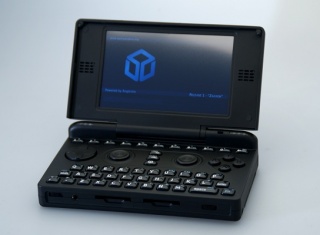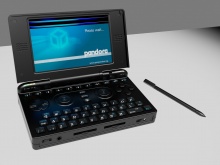Pandora
The Pandora is a combination of a seventh-generation handheld game console and miniature computer. It is the spiritual successor to other open handheld consoles such as the GP32 and GP2X. The device is open, meaning you can use it however you like and there are no restrictions or fees placed on developers, so anyone can write and release software for it. It runs a custom distribution of Linux based on Ångström and is currently the most powerful handheld gaming console available.
Contents
History
On September 30, 2008, 3000 units were made available for pre-order. Later on, this number was increased to 4000. The release of the Pandora was delayed several times until May 2010, when mass production and shipping of the Pandora began. A Production timeline page describes the process.
Availability
For the first batch, 4000 units were made available to be pre-ordered for $330 USD each. Currently (as of September 2010) these are being assembled and shipped out to customers.
A second batch of 4000 was made available for pre-order in July 2010. The price of the second batch is $349 USD. [1]
Capabilities
The Pandora is a unique device. Currently, there is no other device available that has dedicated gaming controls (including two analog nubs) and a QWERTY keyboard. It was developed primarily as a game console, specifically, a device to emulate older systems (see Emulator list) and run native games (see Games). It can also be used as a handheld computer. You can use it to do many of the tasks you would on any other computer, such as browsing the Internet (with a full-featured web browser), listening to music, watching movies and shows, using instant messaging applications, etc.
There are also a few things it can't do. Specifically, it can't run software that is only available for Windows, though if the source code is available there is a possibility it could be ported to run on the Pandora. Also, most proprietary Linux applications won't run without a port (as they were made to run on the x86 architecture while the Pandora is ARM-based).
Specifications
Core Hardware
- Texas Instruments OMAP3530 system-on-chip (SoC): [2] [3] Specifications can be found at this link: [4]
- PowerVR SGX GPU (OpenGL ES 2.0, several million polygons per second). OpenGL ES demonstrated: [5]
- 256MB DDR SDRAM in consumer units (early developer units had 128MB).
- Real-time clock (RTC) built in, to keep track of time: [6]
- 512MB internal flash memory (NAND) for consumer Pandoras (early developer boards had 256MB).
- Is "unbrickable", through a ROM bootloader.
- Dimensions: 140 x 83 x 27 mm (See Size Comparisons).
- Weight: 320g [7] (0.739 lbs).
Display
- 4.3-inch (93.6 x 56.2 mm), 800x480 widescreen (5:3), touchscreen TFT-LCD. [8]
- Brightness: 300 cd/m2, Contrast ratio: 450:1, Response time: tr+tf=30ms. [9]
- TV-out included in hardware, A/V-OUT Port (similar in appearance to a large USB OTG port) has Composite and S-Video outputs and 3.5mm headphone output and microphone input.
- Separate TV-out signals, picture-in-picture capabilities. [10]
- Powerful 2D and 3D hardware acceleration, see above. [11]
Sound
- Has a high-quality audio DAC and an ADC.
- A pair of stereo speakers are built into the sides of the display.
- The hardware volume control is a wheel.
- Built-in microphone. [12]
Input
- Buttons, keyboard, microphone, and touchscreen. [13]
- Directional pad will be a D-pad. [14]
- Two real, custom-designed, plastic analog nubs.
- QWERTY keyboard (cellphone-like, but larger). [15]
Connectivity
- 802.11b/g (Wi-Fi) included. USB host included. USB-on-the-go (one-port host and client) included. [16]
- Integrated Bluetooth 2.0 + EDR (3Mbps). [17]
- USB OTG mini-AB port and fully powered (500 mA) standard-A port. You can use anything that has the appropriate drivers. [18] Some devices need to first go through a powered USB hub.
- RS-232 included, but a level converter is needed for the UART. [19]
- Two SDIO-capable SDHC slots.
Power
- Lithium-polymer battery, ~4000mAh.
- Up to 10-14 hours battery life under reasonable load, 8.5 hours under max CPU load, ~17 hours playing music with the display off (source) (up to 100 hours claimed to be possible with further optimization [20])
- Can charge through an AC adapter or USB. [21]
- Advanced power management capabilities: only need to set a max clock speed; when the CPU is not doing anything it automatically HALTs and does nothing to save power. [22]
- Eventually will be able to suspend to RAM or suspend to disk for longer battery life and faster start up. See Power modes.

